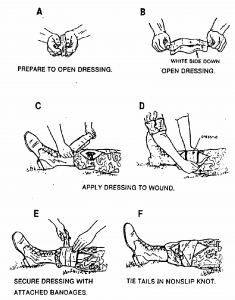NOTE: This paragraph assumes that you have a field first-aid dressing and will apply it to an open wound.
After you have exposed the wound and checked the circulation, apply the field dressing to the wound and secure the dressing using the following procedures.
a. Obtain a Field Dressing.
(1) If the soldier has a field dressing in his plastic individual first aid case, use his field dressing in order to conserve your supplies. If he does not have a field dressing available, use a field dressing from your aid bag.
(2) If the wound is large, you may need to improvise a dressing and bandage from the cleanest materials available.
b. Remove the Field Dressing From the Wrappers.
(1) Locate the notch (slit) in one end of the plastic envelope containing the field dressing.
(2) Beginning at the notch, tear the plastic envelope open and remove the inner packet. The packet is the field dressing in a paper wrapper. Discard the plastic envelope (unless you need it to seal an open chest wound as described in Lesson 3).
(3) Grasp the packet with both hands and twist until the paper wrapper breaks.
(4) Remove the field dressing from the paper wrapper and discard the paper wrapper. Avoid touching the white dressing pad of the field dressing. The pad is sterile and should be kept as free from contamination as possible. Hold on to the tails only.
c. Apply the Dressing to the Wound.
(1) Grasp the folded tails of the field dressing with both hands (figure 2-8 A.)
(2) Hold the field dressing above the exposed wound with the sterile pad of dressing material toward the wound.
(3) Pull on the tails so the dressing opens and flattens (figure 2-8 B).
(4) Place the white dressing pad directly on the wound (figures 2-8 C and D).

(a) If an object (piece of shrapnel, twig from a tree or bush, or such) is protruding from the wound, apply dressings to the wound without covering the protruding object. Procedures for dressing a wound with a protruding object are given in Lesson 8 of this course.
(b) If the fractured end of a bone can be seen, cover the bone with the dressing. Do not attempt to force the bone beneath the skin. Do not attempt to realign the fractured limb.
d. Secure the Dressing.
(1) Place one hand on top of the dressing to hold the dressing in place and to apply pressure to the bleeding blood vessels. If the casualty is conscious, you can have him apply pressure to the dressing while you secure it.
(2) Wrap one of the bandages around the injured limb with your free hand. As you wrap, cover one of the exposed sides of the dressing with the bandage. (The bandage can usually be wrapped around a limb more than once.) Bring the tail back over the dressing.
(3) Wrap the other bandage around the injured body part in the opposite direction (figure 2-8 E). As you wrap, cover the remaining exposed side of the dressing with the bandage. Bring the tail back to the dressing.
(4) Tie the tails in a non-slip knot at the edge of the dressing (figure 2-8 F).
